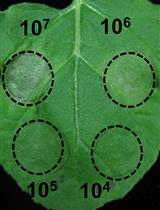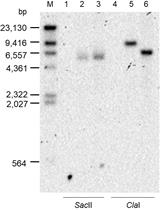- EN - English
- CN - 中文
Stable Transformation of Cyanobacterium Synechocystis sp.
集胞藻细胞的稳定转化
发布: 2014年11月05日第4卷第21期 DOI: 10.21769/BioProtoc.1286 浏览次数: 14113
评审: Tie LiuAnonymous reviewer(s)
Abstract
Cyanobacteria are prokaryotes, which perform oxygenic photosynthesis. Among them, the unicellular cyanobacterium Synechocystis sp. PCC 6803 (hereafter Synechocystis) is a well characterized model system for studies on oxygenic photosynthesis, light signal transduction etc. Moreover, Synechocystis is applied in biotechnological applications (Desai and Atsumi, 2013). Stable transformation of Synechocytis is achieved via the uptake of DNA and incorporation into the host genome by homologous double recombination. This allows for the generation of gene knock-outs (KO) by replacing the coding sequence of the gene of interest by a KO-cassette (comprising of a selection marker flaked by sequences of the gene of interest) or stable overexpression of certain genes of interest after insertion of a corresponding overexpression cassette at a neutral insertion site on the host genome. Stable transformation of Synechocystis was reported by Grigorieva and Shestakov (1982). Since then, variants of the initial protocol have been applied successfully to transform Synechocystis sp. Here we describe a lab-protocol that was applied successfully for stable transformation of Synechocystis (Schwarzkopf et al., 2014).
Keywords: Transformation (转型)Materials and Reagents
- Synechocystis sp. PCC 6803 wild-type (WT) strain [see Schwarzkopf et al. (2014) for details]
- Antibiotics
- Chloramphenicol (Merck KGaA, catalog number: 2366 )
- Kanamycin sulfat (Carl Roth, catalog number: T832.1 )
- Spectinomycin (Duchefa Biochemie, catalog number: S 0188.0025 )
- Chloramphenicol (Merck KGaA, catalog number: 2366 )
- Phyto agar (Duchefa Biochemie, catalog number: P1003.1000 )
- NaNO3 (Carl Roth, catalog number: 8601.2 )
- K2HPO4 (Carl Roth, catalog number: P749.2 )
- MgSO4.7 H2O (Carl Roth, catalog number: P027.2 )
- CaCl2.2 H2O (Sigma-Aldrich, catalog number: 223506 )
- Citric acid (Carl Roth, catalog number: 1818.1 )
- Ferric ammonium citrate (III+) (Carl Roth, catalog number: CN77.1 )
- EDTA Na2 (Carl Roth, catalog number: 8043.2 )
- Na2CO3 (Sigma-Aldrich, catalog number: S-1641 )
- H3BO3 (Carl Roth, catalog number: 6943.3 )
- MnCl2.4 H2O (Sigma-Aldrich, catalog number: M3634 )
- ZnSO4.7 H2O (Merck KGaA, catalog number: 0 143532 )
- Na MoO4.5 H2O (Carl Roth, catalog number: 0274.3 )
- CuSO4.5 H2O (Carl Roth, catalog number: P025.1 )
- Co(NO3)2.6 H2O (Merck KGaA, catalog number: A834336548 )
- Na2S2O3.5 H2O (Merck KGaA, catalog number: K5023616 )
- BG11 medium (see Recipes)
- BG11 agar plates (see Recipes)
- Common antibiotics used (see Recipes)
Equipment
- Petri dishes (Greiner Bio-one, catalog number: 632180 )
- 2 ml-reaction tubes (Eppendorf)
- Tape (Gotha-VLIES, 10 m x 1.25 cm) (Gothaplast, catalog number: PZN-7105417 )
- Centrifuge (Eppendorf, model: 5810R )
- Shaking incubator with illumination (Sartorius, model: Certomat® BS-T )
- Light shelves provided with light bulbs (NARVA LT 36W/760-010 daylight) (Brand-Erbisdorf)
- Photometer (Pharmacia LKB-Ultrospec III)
- Flow cabinet (Heraeus, HERAsafe, model: HS12 )
Procedure
文章信息
版权信息
© 2014 The Authors; exclusive licensee Bio-protocol LLC.
如何引用
Readers should cite both the Bio-protocol article and the original research article where this protocol was used:
- Proels, R. K. (2014). Stable Transformation of Cyanobacterium Synechocystis sp.. Bio-protocol 4(21): e1286. DOI: 10.21769/BioProtoc.1286.
- Schwarzkopf, M., Yoo, Y. C., Huckelhoven, R., Park, Y. M. and Proels, R. K. (2014). Cyanobacterial phytochrome2 regulates the heterotrophic metabolism and has a function in the heat and high-light stress response. Plant Physiol 164(4): 2157-2166.
分类
微生物学 > 微生物遗传学 > 转化
分子生物学 > DNA > 转化
您对这篇实验方法有问题吗?
在此处发布您的问题,我们将邀请本文作者来回答。同时,我们会将您的问题发布到Bio-protocol Exchange,以便寻求社区成员的帮助。
Share
Bluesky
X
Copy link












